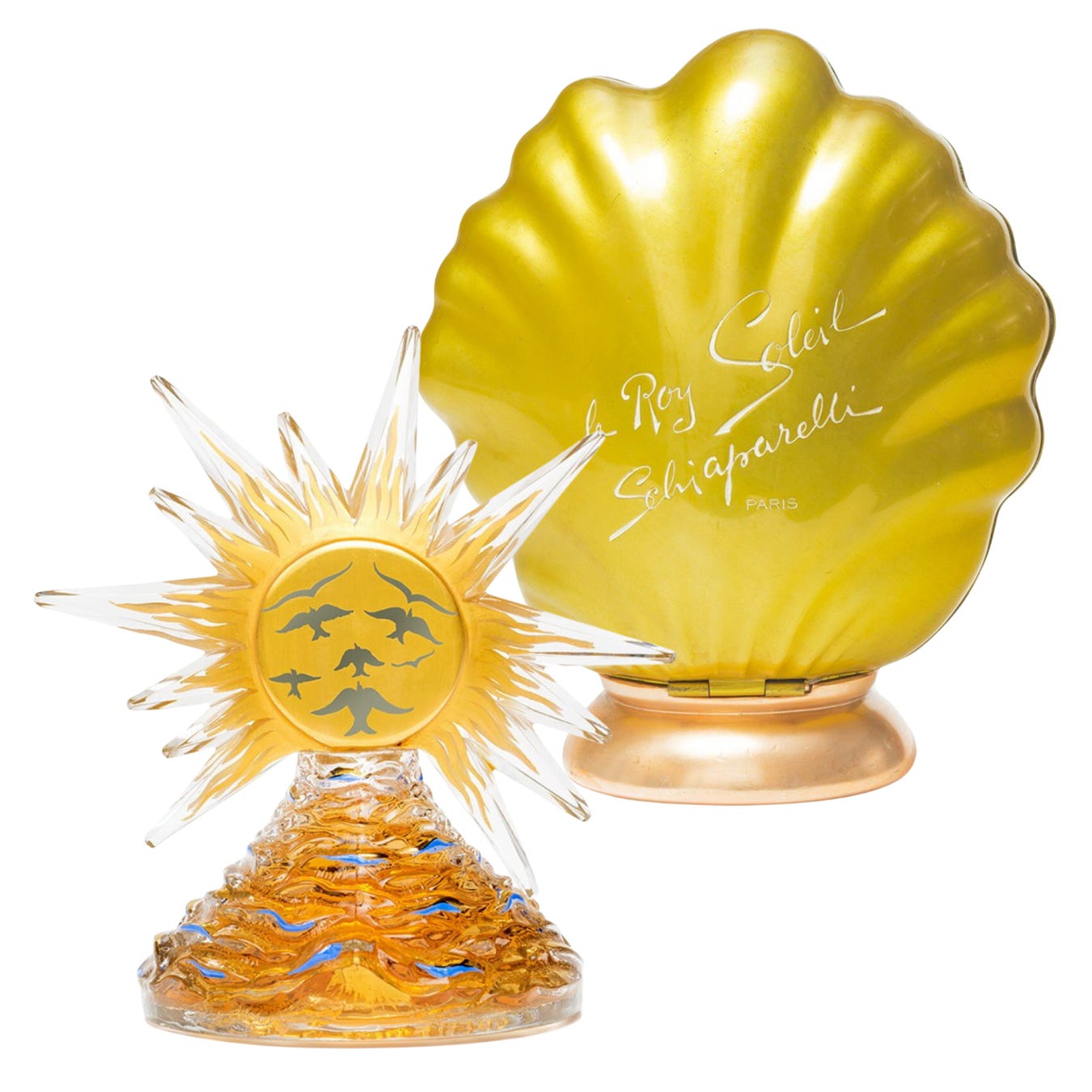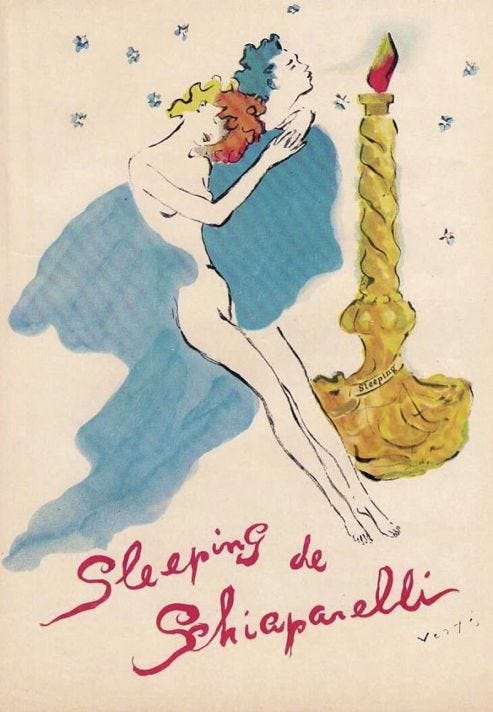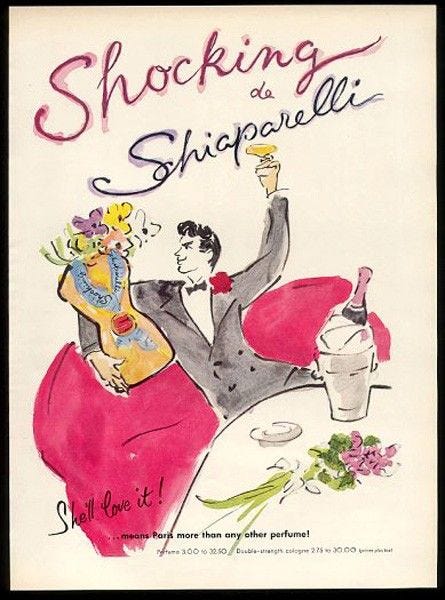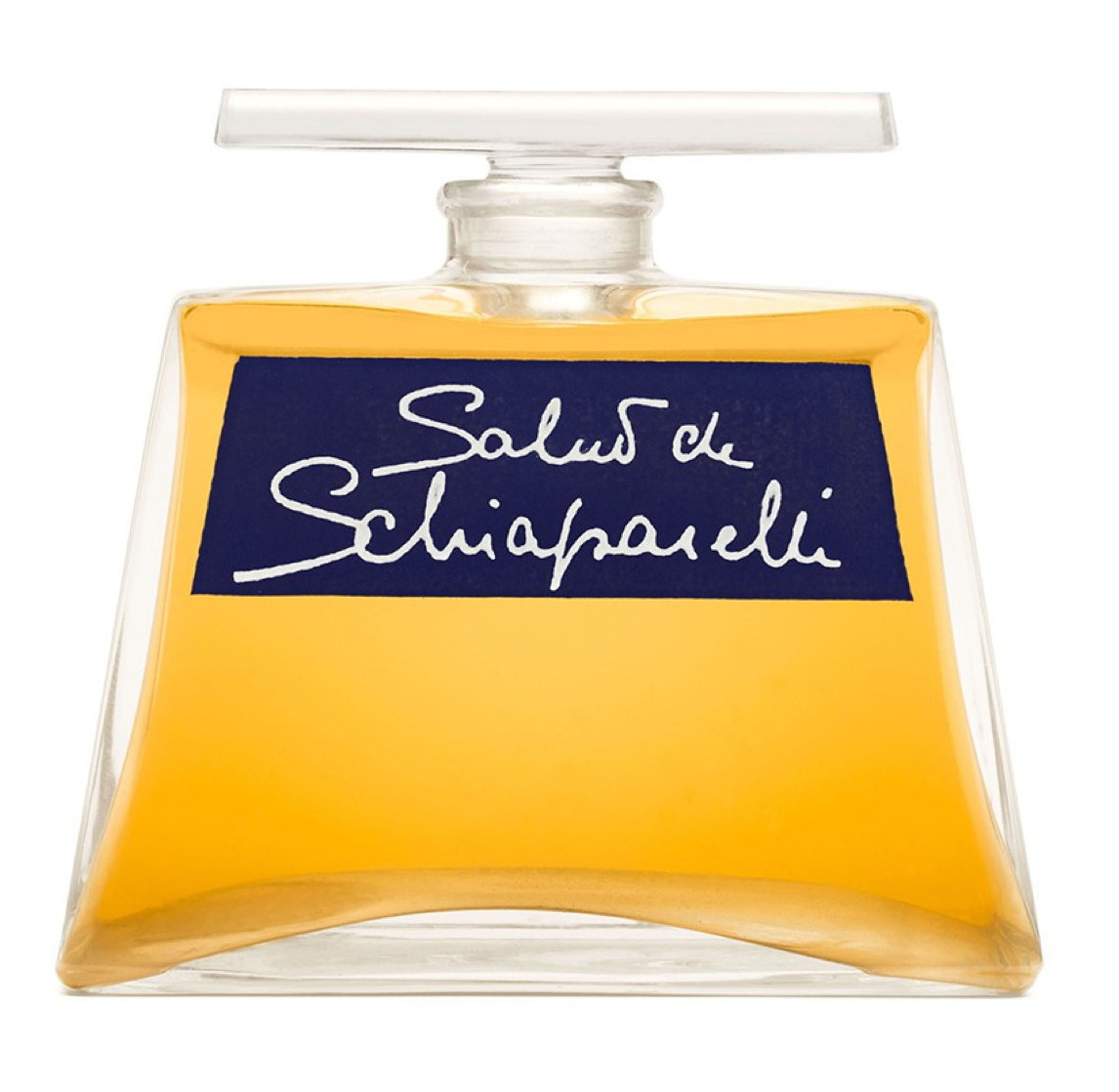What I Learned From Elsa Schiaparelli About Art and Marketing
The power of being unapologetically original
Looking at a watercolor feels like gazing into a dream—soft, fluid, and endlessly captivating. The way the colors mute, blend, and bleed creates a kind of magic. When juxtaposed against the crisp precision of a line drawing, a narrative unfolds, taking shape and meaning, though ambiguous enough to leave space for imagination. There's a sense of childlike wonder in its playfulness, a delight that feels nostalgic and fresh. Lately, I've been tumbling down the watercolor rabbit hole—painting my own and exploring other's work—and, as Pinterest so often does, it swept me straight into the world of Schiaparelli's fragrance ads from the 1930s to 1950s (The Pintest algorithm SEES me).
As someone who spends a lot of time thinking about ads—both as a consequence and a privilege of my work—I often find myself disheartened. Ads that are creative, artistic, and full of imagination rarely perform well. What does? Simple, bright, straightforward ads that make the product unmistakably clear. This fact of advertising in 2025 directly reflects our digital world and its ever-shrinking attention span. You've got half a second—literally—to catch a customer's eye, and if your ad is too complex, whimsical, or even slightly enigmatic, you've lost them. Unless you're Hermès or Loewe—brands with iconic identities that can afford to get weird, and people will still line up to buy. At LES Collection, we don't quite have that luxury. But while our ads might need to perform in the traditional sense, we can still channel a bit of Elsa Schiaparelli's spirit and embrace the weird, the creative, and the whimsical in our editorial content.
So, let's hark back to a time when advertising had more creative freedom, when analytics were absent, and brands launched campaigns that were genuine reflections of their identities. Back then, people had the time to truly absorb an ad, to linger on its details, instead of swiping past in a blur. Ads weren't just selling products; they were telling stories, weaving visions, and inviting us into fantastical worlds. The following are four lessons we can learn from Elsa Schiaparelli about creativity, marketing, and art.
Embrace play
In 1936, Elsa Schiaparelli debuted her first perfume, "Shocking," and enlisted fashion illustrator Marcel Vertès to bring it to life through her signature avant-garde lens. The resulting ads are whimsical and surreal, bursting with fantasy, sensuality, and a sense of uninhibited play. They aren’t polished or overly refined—there's a carefree, almost offhand quality to them, as though Vertès translated his imagination to paper in a rush of inspiration, capturing the essence of the idea without obsessing over perfection. The playfulness comes alive in their imperfections, their bold use of color, and their delightfully strange subject matter: a man on a date with the perfume bottle, a jockey riding the figural bottle, or a woman walking a satyr on a leash with the bottle tied to her waist. They leaned into the absurd, the unexpected, and the fantastical—the results are delightful.
Don’t take yourself too seriously
Schiaparelli's perfume ads were radical for the 1930s and '40s, especially in their unabashed nods to sexuality. "Shocking" came in a bottle shaped like Mae West's iconic hourglass figure (was Kim K channeling Schiaparelli all these years later?), and "Sleeping" was a nighttime scent housed in a crystal candlestick, designed to "light the way to ecstasy" (Can someone bring back nighttime scents, I would be all in). Schiaparelli approached her products and advertising with a cheeky, irreverent attitude—she didn't take herself too seriously, and it showed. Nothing about her campaigns felt overly literal or contrived, unlike today's fragrance ads, where the overt romanticism and hypersexuality feel uninspired, in my humble opinion. By not taking herself too seriously, Schiaparelli created campaigns that still spark dreams and fantasies decades later—proof that a little whimsy goes a long way.
I picked up a vintage bottle of Sleeping and am hunting for Salud du Schiaparelli and Le Roy Soleil. Here is a pretty version of sleeping and here is a version of shocking.
Collaborate
What started as a casual dive into Schiaparelli's perfume ads by Marcel Vertès quickly turned into a full-blown exploration of her creative collaborations—and wow, did she work with the best and boldest artists of her time. Schiaparelli understood something fundamental about art: it’s the ultimate luxury. Collaboration with artist’s was at the heart of her process, and I'm endlessly drawn to it myself. There's something magical about how collaboration pushes both parties to new heights, resulting in something utterly unique. It embodies the LES mantra: you can go further together. An abundance mindset we wholeheartedly embrace. Today, luxury brand collaborations with artists abound, but she was a pioneer, doing it long before it became a trend—and not sparingly, either. Her archives hold a treasure trove of examples, each one proof of the magic found in collaboration.

Be Original
it's the hardest lesson of all. An elusive goal I am constantly chasing as a founder and creative director. There's no simple roadmap, no world-shattering insight I can offer. For me, it's more like a guiding star—something to keep in my mind, a principle to strive for and believe in. Elsa Schiaparelli is the ultimate proof that it can be done. Her work wasn't just unique; it was groundbreaking, a reminder that originality isn't about reinventing the wheel—it's about unapologetically bringing your own vision to life, no matter how bold or unconventional. That's the energy I want to carry forward, always.
While researching this story, I came across a 1st edition copy of Elsa’s memoir “shocking life” I am a sucker for books, especially old and rare-ish copies, so I ordered it right away. I suspect a part II of this story will be coming in the future. Here is a first edition with dust jacket. Here is a less expensive version without the dust jacket.
A recent LES ad for our Ribbon Dinnerware Collection. Our attempt to infuse whimsy while keeping it clear and product-focused. I don’t hate it.
That’s all for today! Thanks for reading!
If you liked this, please share it with a friend, leave a comment, and subscribe! For more creativity, you can follow us on IG and explore years of art and design articles on the LES Journal
Keep reading…
Is It Impossible To Design An Authentic Home?
How do we create a home that feels like an authentic reflection of who we are inside? Asking for a friend. J.K.—asking for myself. It's a deep insecurity of mine that my home doesn't feel like an actual portal into the depths of my soul. Facilitating authentic design is, after all, what I do for a living. Our mission at
What Alessi's Tea And Coffee Piazzas Can Teach Us About Narrative Design
Human hands, cast in silver, reach from nowhere—fingers curling around a perfectly polished rectangular tray. Perched atop: a curious family of objects, seemingly in conversation. Each piece has its own fantastical personality. Their sleek surfaces contrast with richly detailed ornamentation—a round lidded bowl with ears, strands of hair braided into ha…
What is Whimsical Utilitarianism?
My love affair with Bonnie Cashin began on a dreary winter day in NYC. I had time to spare while running errands, so I stopped by Marlene Weatherall, a vintage boutique located amongst the antique shops in Showplace (if you haven't been, it's a must). As I browsed, Marlene, the iconic owner, called out anecdotes and facts about the pieces I grabbed. "Th…



















great reminder to be authentic in business! the ads themselves are so visually inspiring 👏
As somebody who loves Schiaparelli, her collaboration with artists in her practice and the recent taking over by Daniel Roseberry, this was such an exciting read and has taught me so many new things about Elsa and her brand. The imagery presented also reminded by deeply of Cocteau, who Schiaparelli worked with closely for several years. I loved reading this piece and would love to support your work! I write about fashion x art and would love to hear your thoughts on some of my pieces! <3